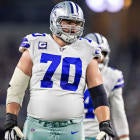Rob Gronkowski didn't show up for the start of the Patriots' voluntary offseason workout program on Monday, which means the five-time All-Pro tight end is jeopardizing the $250,000 workout bonus in his contract. Gronkowski must successfully complete 90 percent of the workouts to get the bonus. There were 33 workouts last year, which didn't include the mandatory three-day minicamp in June; assuming the same number again, Gronkowski can't earn the bonus if he misses more than three workouts.
Some are taking Gronkowski's absence to mean he is undecided about continuing his football career. Gronkowski surprised many after Super Bowl LII with the revelation that he is contemplating retirement, which may have been partially driven by the concussion he suffered against the Jaguars in the AFC Championship game. Patriots owner Robert Kraft recently dismissed the notion of Gronkowski retiring. Others, like myself, have considered the retirement talk as just a negotiating ploy since it first started. The Athletic's Jeff Howe reported that Gronkowski's absence is contract related.
Gronk's contract
Gronkowski signed a six-year, $54 million contract extension in 2012, which made him the NFL's highest-paid tight end by average yearly salary. The extension contained $18.17 million of guarantees. Gronkowski, a 2010 second-round pick, was given the extension after just two NFL seasons, which isn't permissible anymore. Drafted players operating under the rookie wage scale implemented by the 2011 Collective Bargaining Agreement must wait three seasons before being able to sign new deals. He had two years left on his rookie contract prior to signing the extension.
Gronkowski's new deal was originally structured so the Patriots had until the last day of the 2015 league year (early March 2016) to pick up his 2016 through 2019 contract years. A $10 million payment (i.e.; option bonus) due at the end of that March was required to get these four years, containing $27 million in salary. The contract also contained a clause prohibiting the Patriots from designating Gronkowski as a franchise or transition player if the extra years weren't picked up, which would have allowed him to hit the open market.
A contract modification favoring Gronkowski was made when training camp opened in 2015. From his $10 million option bonus, $4 million was given to him as a signing bonus payable almost immediately. The other $6 million remained as an option bonus with the same exercise and payment date as in the 2012 extension.
Gronk's discontent
Gronkowski first publicly expressed displeasure with his situation on Twitter in March 2016 by characterizing New England picking up his option as a pay cut for the final four years of his deal. His view of his contract is quite common among players, where the focus is on the remaining compensation instead of looking at the deal in its entirety.
Drew Rosenhaus, Gronkowski's agent, attempted to get the Patriots to address his client's contract in 2016 when visiting training camp. Not surprisingly, Rosenhaus wasn't successful considering Gronkowski had four years remaining on his contract, which runs through the 2019 season.
The Patriots finally addressed the disgruntled tight end's deal last offseason. $5.5 million of incentives were added only to Gronkowski's 2017 contract year, which contained a $5 million salary. He earned the entire amount when he was named first team All-Pro by The Associated Press.
Gronkowksi is scheduled to make $9 million for the upcoming season and $10 million in 2019. The $9 million consists of an $8 million base salary, $750,000 in game day active-roster bonuses ($46,875 per game) and the previously mentioned $250,000 workout bonus. The same salary components apply to 2019, except Gronkowski's base salary is $9 million. Given's Gronkowski's stance about the option in 2016, he is likely viewing these two years as a pay cut since he made over $10 million in 2017.
Gronkowski has dropped to the fourth-highest paid tight end by average yearly salary since signing in 2012. Two tight-end contracts signed during free agency last month may have provided confirmation to Gronkowski that something more than another short-term fix with incentives should be done with his contract. He is in the exact same place with his existing contract -- two years remaining -- as he was in 2012 when he signed his current deal.
Jimmy Graham got similar money at 31 years old and after a major knee injury in 2015 as he did at 27, when the Saints made him the NFL's first $10 million-per-year tight end a year earlier. He remains the NFL's only $10 million-per-year tight end on his deal with the Packers, although he had a sizable statistical regression last season. With $13 million in the first contract year, Graham's deal is worth up to $30.75 million because of $250,000 in annual incentives.
Trey Burton has become the NFL's sixth-highest-paid tight end by average yearly salary with the four-year, $32 million contract the Bears gave him despite being a largely unproven commodity. He received only limited opportunities with the Eagles over the last four years playing behind Pro Bowl tight end Zach Ertz and 11-year veteran Brent Celek.
Burton has a player-friendly contract structure: $18 million is fully guaranteed at signing, which is essentially the same as the guarantees in Gronkowski's contract. His deal is worth up to $34.8 million because of $2.8 million in annual incentives primarily based on individual statistical achievement. A majority of the incentives will be earned if Burton performs like a Pro-Bowl caliber tight end. Although Burton is actually making $7.8 million in 2018 because half of his $7 million signing bonus isn't payable until next March, Gronkowski won't look at it that way. He'll view Burton's 2018 compensation as $11.3 million because he won't make or acknowledge the distinction with the timing of the signing-bonus payment.
Only one tight end is scheduled to make more than the $19 million Gronkowski is set to receive over the next two years, and that's Graham, who has $22 million in the first two years of his contract.
Gronk's value
Gronkowski is clearly the best tight end in football. In the last three seasons when Gronkowski was healthy (2014, 2015 and 2017), he was named first team All-Pro. Gronkowski was limited to eight games in 2016 because he was slowed by a hamstring problem early in the season and ended the season on injured reserve with a back injury requiring his third back surgery. A torn right ACL and a slower-than-expected recovery from a broken forearm derailed Gronkowski's 2013 season.
Gronkowski leads tight ends with 3,924 receiving yards, 34 touchdown receptions and 15.8 yards per catch (minimum of 100 catches) since the start of the 2014 season despite missing 12 games. The 34 touchdowns are tied for third in the NFL with DeAndre Hopkins. His 3,924 yards are 15th in the NFL during this span.
Unlike most great pass-catching tight ends, Gronkowski is also an excellent blocker. He is New England's most important offensive player outside of quarterback Tom Brady, the reigning league MVP. Since Gronkowski is the ultimate mismatch in the passing game, he can make a legitimate case that he has transcended his position and should be compared to game's best pass catchers instead of just tight ends.
Gronkowski's compensation pales in comparison. Antonio Brown, who is also represented by Rosenhaus, sets the wide-receiver market with the $17 million-per-year extension he signed with the Steelers in 2017. Hopkins helped advance the ball for wide receivers by setting new standards for pass catchers last preseason with $49 million in overall guarantees and $36.5 million fully guaranteed at signing, which have since been eclipsed by Mike Evans. The Buccaneers last month gave the 2014 first-round pick a five-year extension averaging $16.5 million per year with $55.008 million in guarantees, where $38.258 million is fully guaranteed.
Wide-receiver salaries have exploded while the tight-end market has remained fairly stagnant. The Chiefs surprisingly gave Sammy Watkins a three-year, $48 million contract with $30 million fully guaranteed in free agency last month. The 2014 fourth-overall pick is being paid like an elite receiver without matching production. Watkins caught a rather pedestrian 39 passes for 593 yards and eight touchdowns with the Rams last season after being traded from the Bills during training camp. Prior to the trade, the Bills passed on a fifth-year option in 2018 for Watkins at $13.258 million due to persistent problems with his broken left foot. The Bears signed Allen Robinson to a three-year, $42 million contract with $25.2 million in guarantees although he is still recovering from the left ACL he tore in the Jaguars' 2017 season opener.
The top of the second tier of wide-receiver deals is now in the $13 million-per-year range, with between $25 million and $30 million of guarantees. For example, the Eagles gave Alshon Jeffery a four-year, $52 million extension with slightly more than $27.25 million in guarantees late last season.
Paying Gronk while protecting the Patriots
Any Gronkowski deal needs to give New England some protection against additional injuries and an early retirement while also adequately compensating him. This could be accomplished by utilizing the same basic structure in Gronkowski's existing contract, where more substantial per-game roster bonuses are in the new years.
Paying Gronkowski in the second tier of wide-receiver deals doesn't seem unreasonable, especially when adjusting his existing contract into a 2018 salary-cap environment. The salary cap was $120.6 million when Gronkowski signed his extension in 2012. The equivalent contract under the current $177.2 million salary cap averages approximately $13.25 million per year with slightly under $27 million in guarantees.
The following contract is an illustration of what the Patriots could do using these principles.
Signing bonus: $8 million ($5 million within two weeks of execution; $3 million payable on 10/31/19)
Guaranteed money: $25 million
Fully guaranteed at signing: $25 million
Option bonus (exercise window as first through third days of 2020 league year): $12 million ($6 million within two weeks of exercising option; $4 million payable on 10/31/21 and $2 million payable on 10/31/22)
New money total: $38 million ($57 million over five years)
Contract length: 3-year extension
Average per year: $12,666,667
Base salary | Per-game roster bonus | Workout bonus | Signing bonus proration | Option bonus proration | Salary cap number | Cash flow | |
2018* | $8,000,000 | $750,000 | $250,000 | $2,400,000 | $1,200,000 | $12,506,250 | $14,000,000 |
2019* | $9,000,000 | $750,000 | $250,000 | $2,400,000 | $1,200,000 | $13,600,000 | $27,000,000 |
2020 (option) | $2,750,000 | $2,000,000 | $250,000 | $1,600,000 | $4,000,000 | $10,600,000 | $38,000,000 |
2021 (option) | $3,750,000 | $2,000,000 | $250,000 | $1,600,000 | $4,000,000 | $11,600,000 | $48,000,000 |
2022 (option) | $4,750,000 | $2,000,000 | $250,000 | $1,600,000 | $4,000,000 | $12,600,000 | $57,000,000 |
* Base salary guaranteed for skill, injury and salary cap.
Option for 2020 through 2022 years must be exercised between 1st and 3rd day of 2020 league year; $12 million payment required with exercise of option.
Making sense of the suggested contract
Gronkowski's 2018 and 2019 contract years stay the same except the base salaries become fully guaranteed and this year's workout bonus, which isn't going to be earned, is turned into a bonus for reporting to training camp on time. The cap numbers in these years each increase by $1.6 million because of the $8 million signing bonus. With a little under $14 million in cap space remaining this year, the Patriots shouldn't have a problem handling a modest increase in Gronkowski's cap number. Gronkowski's $14 million in 2018 would be $1 million more than Graham's first-year compensation in his Green Bay contract.
The $12 million option-bonus payment to pick up the three new years gives New England flexibility in case Gronkowski decides to retire when his current contract is set to expire or his skills start to diminish because of injuries. The Patriots would have a $4.8 million cap charge in 2020 if they didn't pick up the option years or Gronkowski didn't want to play anymore.
The option bonus gets prorated just like a signing bonus. The Patriots would be smart to insist on a mechanism where they could elect to make the option bonus a signing bonus, instead, to give them more rights to recover money should Gronkowski retire after the option is exercised. This is something the Panthers did with Luke Kuechly and Cam Newton's contracts, which have the same signing bonus/option bonus structure as Gronkowski's. The CBA gives teams the right to recover the remaining prorated amounts of signing bonuses when a player retires. Recovery of an option bonus can occur only during the year in which it is earned. That would be 2020 in Gronkowski's case. With the $12 million staying as an option bonus, the Patriots wouldn't be able to get anything from it if he retired in 2021 or 2022.
The Lions were entitled to collect $3.2 million of the $16 million signing bonus Calvin Johnson received in his 2012 extension when he retired after the 2015 season. The exact amount the Lions got from Johnson isn't known but he has acknowledged that having to write them a check has impacted his relationship with the organization. Some teams don't assert their rights when players retire. The Seahawks didn't ask for any money back from Marshawn Lynch during his one-year hiatus from the NFL. The deferral of the $12 million bonus makes recovery easier because the remaining payment(s) to Gronkowski could be withheld to help cover the amount owed.
Assuming the option bonus was reclassified as signing bonus and Gronkowski retired after the 2020 season, the Patriots would be entitled to $11.2 million from the $8 million signing bonus and other $12 million, since that's the prorated amounts in the final two years. The final two installments for the $12 million could be withheld so Gronkowski would be paying back the other $5.2 million if New England sought recovery. Technically, New England would need to wait until 2022 under CBA rules before attempting to collect the $5.6 million of bonus proration associated with that year.
There are salary-cap considerations which give New England incentive to pursue the money. The Patriots would get a cap credit equal to the money actually repaid or legitimately withheld.
The bigger game-day active roster bonuses in the three new years would give the Patriots more financial and cap relief if Gronkowski sustained another serious injury. The $125,000 per-game amount is only payable provided Gronkowski is on the 46-man active roster for that particular game. $2 million may seem excessive but it isn't something Rosenhaus hasn't agreed to before. NaVorrro Bowman's 2016 extension with the 49ers had $2 million of annual per-game active roster bonuses in his new years. Previously, Rosenhaus was comfortable with $2 million in annual per-game roster bonuses in most of the years of Frank Gore's veteran contracts with the 49ers.
This basic concept could be applicable to a different team if the Patriots trade Gronkowski this year instead of addressing his contract. An alternative way to accomplish the same thing would be for 2020 through 2022 to remain as option years without the $12 million payment required for these years, where the exercise date would be the last day of the 2019 league year (mid-March 20). Instead, there would be a $12 million first-day-of-the-league-year roster bonus guaranteed for skill and salary cap that the team would have the right to convert into signing bonus added in 2020.

















